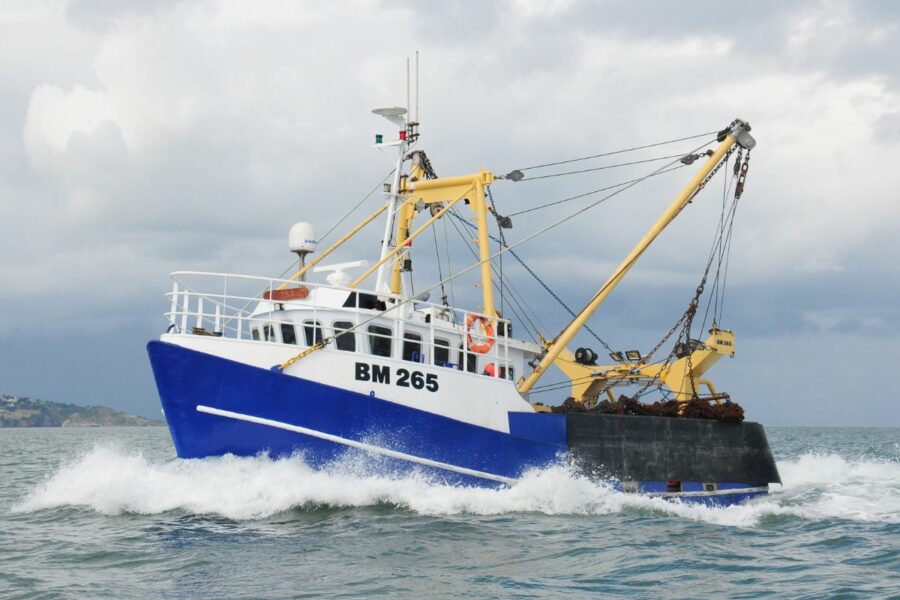The Marine Accident Investigation Branch (MAIB) has issued its report into the loss of the 14m scalloper Joanna C BM 265 five nautical miles south of Newhaven on 21 November, 2020, leading to the death of two of its crew, reports Gaby Bartai.
The vessel had left Newhaven on the evening of 19 November, and had been fishing for 31 hours when the accident occurred.
At about 5am on 21 November, the vessel had completed a tow and the crew were preparing to haul the dredges. Skipper David Bickerstaff was in the wheelhouse to operate the winch controls, mate Robert Morley was on deck and deckhand Adam Harper was resting in his bunk.
At about 5.15am, as the dredges were being raised, David Bickerstaff noticed a rope – determined later to be part of a string of whelk pots – tangled around the starboard dredge bar. As Joanna C began to heel to starboard, he attempted to lower the derricks, but the starboard dredge swung away from the side of the vessel and Joanna C continued to roll.
Robert Morley was thrown into the water. Joanna C inverted rapidly and remained floating, with David Bickerstaff and Adam Harper trapped inside.
David Bickerstaff found his way to the bunk room, where he and Adam Harper remained for around 40 minutes. When the vessel began to sink, they attempted to escape, but while the skipper surfaced and survived by clinging to a lifebuoy, the deckhand remained trapped.
Rescue services were alerted by the vessel’s EPIRB, and RNLI lifeboats and Coastguard helicopters were tasked to the scene. Nearby fishing vessels also joined the search. The Newhaven all-weather lifeboat recovered David Bickerstaff from the water at 8.51am, and he was discharged from hospital the following day.
The search for the two missing crewmen was terminated at 3pm on 22 November. The body of Adam Harper was recovered from the wreck the following day, and on 14 December, Robert Morley’s body was found on Bexhill beach.
After the capsize, Joanna C’s float-free liferaft was released, but did not inflate because of insufficient buoyancy to trigger the mechanism. The report concluded that this adversely affected the survival chances of the crewmen in the water. An urgent MAIB safety recommendation was made to the British Standards Institution to propose the introduction of a minimum buoyancy requirement for liferafts.
The MAIB’s investigation – the purpose of which is not to determine liability or apportion blame – found that the Joanna C had been modified several times during its 40 years of operation, including extensive modifications in 2007 and 2019, ‘the cumulative effect of which eroded Joanna C’s reserves of stability and increased the vessel’s vulnerability to capsize’.
The report concludes that the detrimental effect of the modifications was unknown to the crew and regulator alike because, although a stability assessment was begun after the 2019 modifications, the analysis was never completed.
The report states: “The extensive 2019 modifications to Joanna C were almost certainly the main factor in reducing the margin of positive stability to a level where the vessel had a dangerously low reserve. Although the owner had sought advice from a naval architect, he was not involved in the modifications’ design and there was no stability assessment of the vessel before work began.
“In addition, despite being involved in funding applications for parts of the work, the MCA was not notified of the proposed modification and consequentially there was no regulatory oversight or approval of the process.”
Chief inspector of marine accidents Andrew Moll said: “Joanna C capsized because it had insufficient reserves of stability to recover from the heel created when the fishing gear became snagged. This happened because of modifications to the vessel that had severely eroded its stability characteristics, and this went undetected.”
The MAIB has made a safety recommendation (2022/124) to the MCA to ensure that stability requirements for small fishing vessels are applied as intended and that, where stability checks are required, fishing operations should be suspended until a vessel has been satisfactorily assessed.
A safety flyer has been released to the fishing industry highlighting the need to consider the impact that modifications could have to a vessel’s stability, and the importance of checking that where ‘float free’ arrangements are in place, the buoyancy of a liferaft will be sufficient to trigger the inflation mechanism.
The full MAIB report can be read here.
Photo by: Martin Johns
This story was taken from the latest issue of Fishing News. For more up-to-date and in-depth reports on the UK and Irish commercial fishing sector, subscribe to Fishing News here or buy the latest single issue for just £3.30 here.








